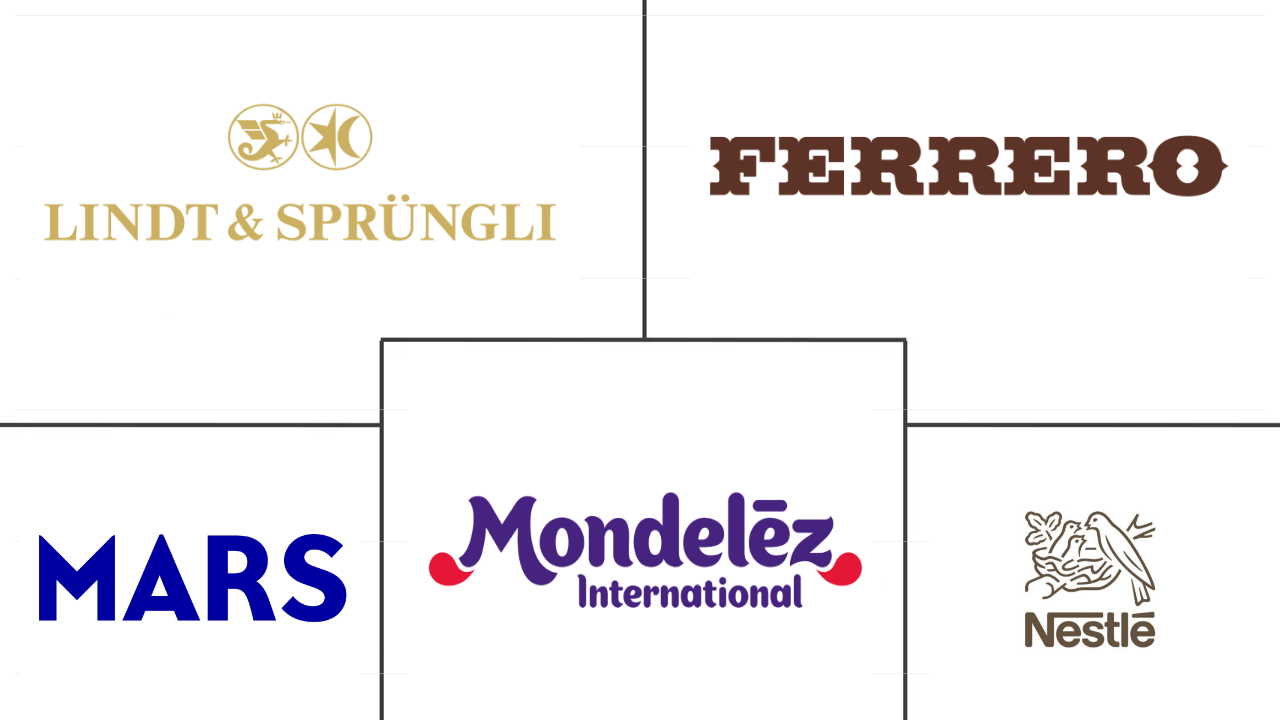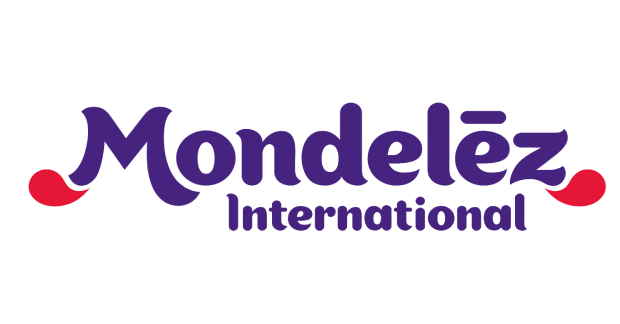Market Size of uk confectionery Industry
| Icons | Lable | Value |
|---|---|---|
|
|
Study Period | 2018 - 2030 |
|
|
Market Size (2024) | USD 16.18 Billion |
|
|
Market Size (2030) | USD 22.06 Billion |
|
|
Largest Share by Distribution Channel | Convenience Store |
|
|
CAGR (2024 - 2030) | 5.30 % |
|
|
Fastest Growing by Distribution Channel | Online Retail Store |
|
|
Market Concentration | Medium |
Major Players |
||

|
||
|
*Disclaimer: Major Players sorted in no particular order |
UK Confectionery Market Analysis
The UK Confectionery Market size is estimated at 16.18 billion USD in 2024, and is expected to reach 22.06 billion USD by 2030, growing at a CAGR of 5.30% during the forecast period (2024-2030).
16.18 Billion
Market Size in 2024 (USD)
22.06 Billion
Market Size in 2030 (USD)
4.43 %
CAGR (2018-2023)
5.30 %
CAGR (2024-2030)
Largest Segment by Confections
72.94 %
value share, Chocolate, 2023
Growing popularity of dark chocolate due to its health benefits, along with growing artisanal chocolate makers in the United Kingdom, is making chocolate the largest segment.
Largest Segment by Distribution Channel
40.49 %
value share, Convenience Store, 2023
The wider range of confectionery products and feasibility in location by convenience stores, driven by impulse buying behavior, makes it a major market distribution channel.
Fastest-growing Segment by Confections
7.70 %
Projected CAGR, Snack Bar, 2024-2030
Consumers are replacing conventional snacks with snack bars, growing and witnessing an ever-expanding array of flavors and healthy varieties to supplement eating habits.
Fastest-growing Segment by Distribution Channel
6.22 %
Projected CAGR, Online Retail Store, 2024-2030
The freedom to browse digital catalogs without any hurry in a priceless manner, with quick deliveries to the right place, has become the major factor driving the segment.
Leading Market Player
17.96 %
market share, Mondelēz International Inc., 2022

The active market activities, like product innovations and strategic moves by Mondelēz, along with the unique portfolio, are enabling the company to grow ales in the market.
Supermarkets, hypermarkets, and convenience stores collectively account for more than 75% of the market share due to their longer opening hours and access to a wide range of confectionery brands
- Convenience stores are the leading distribution channels for confectionery products in the country. The sales value of confectionery products through convenience stores increased by 4.3% in 2023 compared to the previous year. The major factor behind this growth was the ease of access and longer opening hours compared to modern stores. These factors boost the sales of confectionery products.
- Supermarkets and hypermarkets are the second most widely preferred distribution channels after convenience stores. The sales value of confectionery products through supermarkets and hypermarkets registered a growth rate of 9.42% from 2021 to 2023. These retail channels have a strong position due to the wide selection of brands offered, considerable shelf space, frequent price promotions, and the rising demand for confectionery products such as chocolates, candies, sugar-free gums, snack bars, and others that are widely accessible at supermarkets and hypermarkets.
- Supermarkets offer discounted prices for bulk purchases of confectioneries. Key supermarket chains, including Aldi, Tesco, Asda, Sainsbury, and Morrisons, sell 650 g of chocolate boxes for USD 5.24, 100 g boxes for USD 1.78, and 382 g boxes for USD 4.57 in the United Kingdom. These retail channels also offer cashback and rewards when consumers buy products from their online websites.
- Online retail channels are expected to grow at the highest rate during the forecast period due to factors such as convenience, discounted rates, and one-day delivery options. The sales value of confectionery products through online retail channels is anticipated to register a CAGR of 5.95% from 2023 to 2030.
UK Confectionery Industry Segmentation
Chocolate, Gums, Snack Bar, Sugar Confectionery are covered as segments by Confections. Convenience Store, Online Retail Store, Supermarket/Hypermarket, Others are covered as segments by Distribution Channel.
- Convenience stores are the leading distribution channels for confectionery products in the country. The sales value of confectionery products through convenience stores increased by 4.3% in 2023 compared to the previous year. The major factor behind this growth was the ease of access and longer opening hours compared to modern stores. These factors boost the sales of confectionery products.
- Supermarkets and hypermarkets are the second most widely preferred distribution channels after convenience stores. The sales value of confectionery products through supermarkets and hypermarkets registered a growth rate of 9.42% from 2021 to 2023. These retail channels have a strong position due to the wide selection of brands offered, considerable shelf space, frequent price promotions, and the rising demand for confectionery products such as chocolates, candies, sugar-free gums, snack bars, and others that are widely accessible at supermarkets and hypermarkets.
- Supermarkets offer discounted prices for bulk purchases of confectioneries. Key supermarket chains, including Aldi, Tesco, Asda, Sainsbury, and Morrisons, sell 650 g of chocolate boxes for USD 5.24, 100 g boxes for USD 1.78, and 382 g boxes for USD 4.57 in the United Kingdom. These retail channels also offer cashback and rewards when consumers buy products from their online websites.
- Online retail channels are expected to grow at the highest rate during the forecast period due to factors such as convenience, discounted rates, and one-day delivery options. The sales value of confectionery products through online retail channels is anticipated to register a CAGR of 5.95% from 2023 to 2030.
| Confections | |||||||||||
| |||||||||||
| |||||||||||
| |||||||||||
|
| Distribution Channel | |
| Convenience Store | |
| Online Retail Store | |
| Supermarket/Hypermarket | |
| Others |
UK Confectionery Market Size Summary
The UK confectionery market is experiencing a robust growth trajectory, driven by evolving consumer preferences and strategic distribution channels. Convenience stores lead the market, offering easy access and extended hours, which have significantly boosted sales. Supermarkets and hypermarkets follow closely, benefiting from a wide range of brands, ample shelf space, and frequent promotions. These retail channels are particularly appealing due to their bulk purchase discounts and online cashback offers. The online retail sector is poised for the fastest growth, attributed to its convenience, competitive pricing, and rapid delivery options. The market is characterized by a diverse consumer base, with chocolate being a favored choice among individuals aged 25 to 34, and a notable frequency of purchase across various age groups.
Brand loyalty plays a crucial role in consumer decisions within the UK confectionery market, with Gen Z and Millennials showing the highest allegiance to specific brands and retailers. Packaging innovation also significantly influences purchasing behavior, attracting a substantial portion of consumers. Major brands like Lindt, Mars, Ferrero, and Cadbury dominate the market, offering products in various formats to cater to a broader audience. The market is moderately consolidated, with leading companies holding a significant share. Recent product launches and partnerships, such as Swizzels' collaboration with Applied Nutrition and Nestlé's new chocolate bar, highlight the ongoing innovation and adaptation to consumer trends. Despite health considerations, chocolate remains a popular treat, reflecting the dynamic nature of the UK confectionery market.
UK Confectionery Market Size - Table of Contents
-
1. MARKET SEGMENTATION (includes market size in Value in USD and Volume, Forecasts up to 2030 and analysis of growth prospects)
-
1.1 Confections
-
1.1.1 Chocolate
-
1.1.1.1 By Confectionery Variant
-
1.1.1.1.1 Dark Chocolate
-
1.1.1.1.2 Milk and White Chocolate
-
-
-
1.1.2 Gums
-
1.1.2.1 By Confectionery Variant
-
1.1.2.1.1 Bubble Gum
-
1.1.2.1.2 Chewing Gum
-
1.1.2.1.2.1 By Sugar Content
-
1.1.2.1.2.1.1 Sugar Chewing Gum
-
1.1.2.1.2.1.2 Sugar-free Chewing Gum
-
-
-
-
-
1.1.3 Snack Bar
-
1.1.3.1 By Confectionery Variant
-
1.1.3.1.1 Cereal Bar
-
1.1.3.1.2 Fruit & Nut Bar
-
1.1.3.1.3 Protein Bar
-
-
-
1.1.4 Sugar Confectionery
-
1.1.4.1 By Confectionery Variant
-
1.1.4.1.1 Hard Candy
-
1.1.4.1.2 Lollipops
-
1.1.4.1.3 Mints
-
1.1.4.1.4 Pastilles, Gummies, and Jellies
-
1.1.4.1.5 Toffees and Nougats
-
1.1.4.1.6 Others
-
-
-
-
1.2 Distribution Channel
-
1.2.1 Convenience Store
-
1.2.2 Online Retail Store
-
1.2.3 Supermarket/Hypermarket
-
1.2.4 Others
-
-
UK Confectionery Market Size FAQs
How big is the UK Confectionery Market?
The UK Confectionery Market size is expected to reach USD 16.18 billion in 2024 and grow at a CAGR of 5.30% to reach USD 22.06 billion by 2030.
What is the current UK Confectionery Market size?
In 2024, the UK Confectionery Market size is expected to reach USD 16.18 billion.

